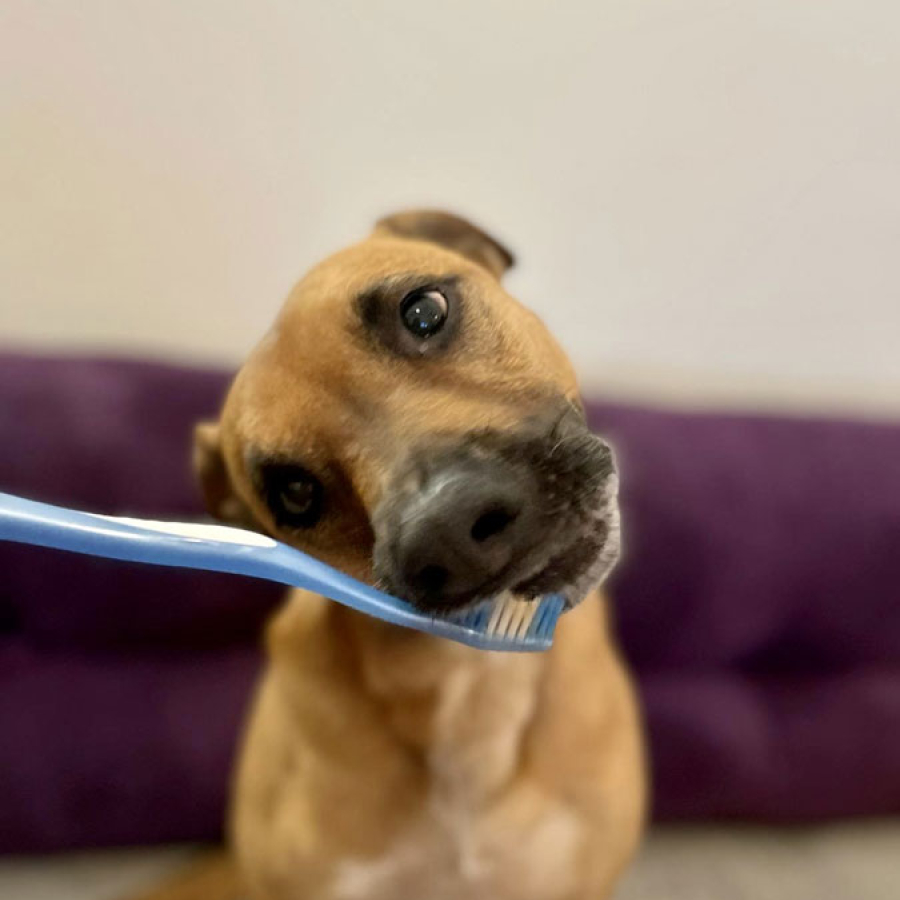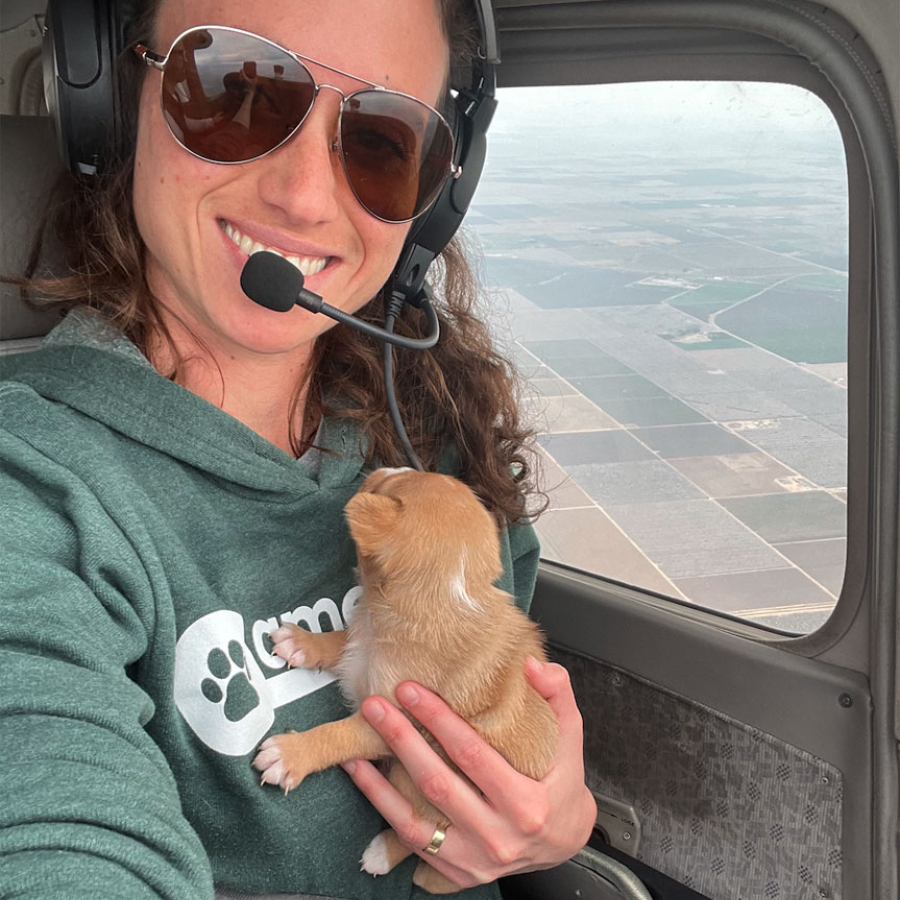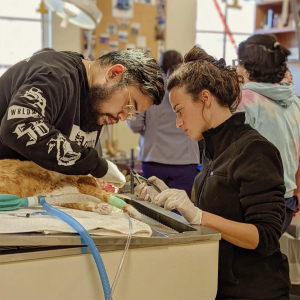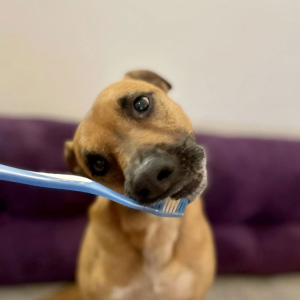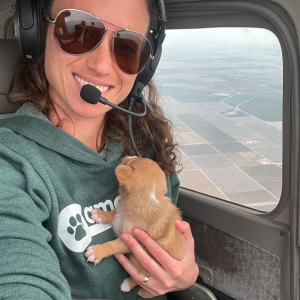Passionate about animal rescue, Adi Chatow, DVM, always knew she wanted to help animals. Raised in Israel, she moved to California with her parents when she was in high school. After completing her Doctor of Veterinary Medicine degree at UC Davis Veterinary School, Dr. Adi and her husband decided to move to New Orleans, which they enjoyed visiting during Jazz Fest and explored further during subsequent trips. Dr. Adi has a female mixed breed dog named Skooner and a newly adopted kitten named Pita. She recently joined the veterinarians at Metairie Small Animal Hospital.
Dr. Adi is a private pilot of a Cesna 172 four-seater airplane and is Operations Coordinator and Pilot for the Amelia Air Animal Rescue organization. Amelia Air has an ambitious goal to save 500 animals every year by moving animals from rural animal shelters (that don’t have the resources to place pets in homes and usually end up euthanizing them) to no-kill rescue organizations that specialize in finding forever homes for pets.
Dr. Adi reminds us that February is National Pet Dental Health Month! Dental disease is one of the most common conditions seen by veterinarians. Approximately two-thirds of pets over three years of age have some degree of dental disease. The most common dental problems seen in small pets are caused by periodontal disease, an inflammation or infection of the tissues surrounding the tooth. As the bacteria in the mouth multiplies on the surfaces of the teeth, they form an invisible layer called plaque. Some of this plaque is removed naturally by the pet's tongue and chewing habits. If allowed to remain on the tooth surface, the plaque thickens and becomes mineralized, forming tartar. The tartar accumulates above and below the gumline and presses on the gums, causing inflammation called gingivitis. Tartar is easily identified by its tan or brown color. It normally starts at the gum edge, especially on the back teeth. Infection soon follows and the gums recede further, exposing sensitive unprotected tooth root surfaces and the bony tooth sockets. The bone and ligaments that support the teeth are destroyed, leading to excessive tooth mobility and eventual tooth loss. Infection around the socket causes the formation of pus and a foul odor, and may spread into the tooth socket creating an abscess, or even more severe problems, eventually causing the tooth to fall out.
Once periodontal disease starts, the degenerative changes to the tooth and its support structures cannot be reversed. These changes also make it easier for more plaque and tartar to collect, resulting in further disease. As the oral infection progresses, inflammation of the tonsils and pharynx can occur. The bacteria can also be absorbed into the bloodstream and be carried to other organs, causing infections in the heart valves, as well as in the kidneys or liver if left untreated. It’s imperative to address periodontal disease to prevent further medical complications and to maintain the general health of our pets. If the disease is caught at an early stage and a thorough veterinary dental scaling and polishing performed, most of the teeth and gums will have a full recovery.
Dr. Adi points out that there are a number of signs that should alert you to dental disease in your pet. Your pet may show a decreased interest in food or approach the food bowl and then show a reluctance to eat. It may chew with obvious caution and discomfort, drop food from their mouth, or may swallow with difficulty. Drooling may be seen, possibly with blood, and there may be an unpleasant odor to the breath. In some cases, the pets may be seen pawing at their mouths or shaking their heads. A reluctance to eat may lead to weight loss. Many pets will refuse dry food and demonstrate a preference for moist or canned foods. Dental disease and oral pain may account for the “finicky appetites” that many dogs and cats with dental disease display.
If you see that your pet has evidence of tartar accumulation, gingivitis or is exhibiting any signs of mouth pain or discomfort, Dr. Adi recommends taking it to your veterinarian for an examination. You will be advised of the most appropriate course of treatment, which may involve having the pet’s teeth examined and cleaned under short-acting sedation or general anesthesia.
A routine dental cleaning involves a thorough dental examination, followed by a dental scaling and polishing to remove the tartar and invisible plaque from all of the tooth surfaces. Once your pet is sedated or anesthetized, your veterinarian will thoroughly examine their mouth, noting the alignment of the teeth and the extent of tartar accumulation. If periodontal disease is severe, it may not be possible to save badly affected teeth, which may need to be extracted. Next, tooth scaling will be performed using hand scalers and ultrasonic cleaning equipment to remove all traces of tartar. The tartar below the gum line causes the most significant gum recession so it is important that it is removed thoroughly. After scaling, the teeth are polished to remove microscopic scratches in order to help prevent subsequent plaque build-up. Special applications such as fluoride, antibiotic preparations and cleaning compounds may be indicated to decrease tooth sensitivity, strengthen enamel, treat bacterial infection and reduce future plaque accumulation. Dental radiographs are taken to complete the examination and to determine the health of the tooth roots and bony structures supporting the teeth below the gumline.
The best way to prevent dental disease is to keep the mouth as hygienic as possible and to reduce the rate at which tartar builds up on the teeth. The most effective way of reducing plaque and tartar is to brush the teeth on a regular basis. A number of toothpastes and brushes made specifically for pets are available that are designed to be swallowed and built for animals’ mouth structure. With gentleness, patience, perseverance, and lots of treats, it is possible to regularly clean some pets’ teeth this way. If brushing isn’t tolerated, a range of antibacterial mouthwashes and gels can be applied to the teeth and mouth to reduce the number of bacteria present. Recent advances in nutrition have resulted in diets and chew treats and toys that are designed to reduce tartar accumulation by mechanically assisting in plaque removal.
Annual dental cleaning at your vet’s hospital is highly recommended for general maintenance of your pets’ teeth and health. Metairie Small Animal Hospital is proud to offer special discounted rates to their dental services during the month of February to honor the National Pet Dental Health Month. You can give them a call with any questions or to make an appointment.
Metairie Small Animal Hospital has been serving the New Orleans metropolitan area since 1946. From humble beginnings, it has evolved to keep pace with the ever-increasing technology and medical advances. In addition to the Main Hospital on Metairie Road, they also operate five outpatient clinics in Kenner, Metairie, Lakeview, Freret Street, and the Marigny in New Orleans to better serve their clients.
Dr. Adi is a private pilot of a Cesna 172 four-seater airplane and is Operations Coordinator and Pilot for the Amelia Air Animal Rescue organization. Amelia Air has an ambitious goal to save 500 animals every year by moving animals from rural animal shelters (that don’t have the resources to place pets in homes and usually end up euthanizing them) to no-kill rescue organizations that specialize in finding forever homes for pets.
Dr. Adi reminds us that February is National Pet Dental Health Month! Dental disease is one of the most common conditions seen by veterinarians. Approximately two-thirds of pets over three years of age have some degree of dental disease. The most common dental problems seen in small pets are caused by periodontal disease, an inflammation or infection of the tissues surrounding the tooth. As the bacteria in the mouth multiplies on the surfaces of the teeth, they form an invisible layer called plaque. Some of this plaque is removed naturally by the pet's tongue and chewing habits. If allowed to remain on the tooth surface, the plaque thickens and becomes mineralized, forming tartar. The tartar accumulates above and below the gumline and presses on the gums, causing inflammation called gingivitis. Tartar is easily identified by its tan or brown color. It normally starts at the gum edge, especially on the back teeth. Infection soon follows and the gums recede further, exposing sensitive unprotected tooth root surfaces and the bony tooth sockets. The bone and ligaments that support the teeth are destroyed, leading to excessive tooth mobility and eventual tooth loss. Infection around the socket causes the formation of pus and a foul odor, and may spread into the tooth socket creating an abscess, or even more severe problems, eventually causing the tooth to fall out.
Once periodontal disease starts, the degenerative changes to the tooth and its support structures cannot be reversed. These changes also make it easier for more plaque and tartar to collect, resulting in further disease. As the oral infection progresses, inflammation of the tonsils and pharynx can occur. The bacteria can also be absorbed into the bloodstream and be carried to other organs, causing infections in the heart valves, as well as in the kidneys or liver if left untreated. It’s imperative to address periodontal disease to prevent further medical complications and to maintain the general health of our pets. If the disease is caught at an early stage and a thorough veterinary dental scaling and polishing performed, most of the teeth and gums will have a full recovery.
Dr. Adi points out that there are a number of signs that should alert you to dental disease in your pet. Your pet may show a decreased interest in food or approach the food bowl and then show a reluctance to eat. It may chew with obvious caution and discomfort, drop food from their mouth, or may swallow with difficulty. Drooling may be seen, possibly with blood, and there may be an unpleasant odor to the breath. In some cases, the pets may be seen pawing at their mouths or shaking their heads. A reluctance to eat may lead to weight loss. Many pets will refuse dry food and demonstrate a preference for moist or canned foods. Dental disease and oral pain may account for the “finicky appetites” that many dogs and cats with dental disease display.
If you see that your pet has evidence of tartar accumulation, gingivitis or is exhibiting any signs of mouth pain or discomfort, Dr. Adi recommends taking it to your veterinarian for an examination. You will be advised of the most appropriate course of treatment, which may involve having the pet’s teeth examined and cleaned under short-acting sedation or general anesthesia.
A routine dental cleaning involves a thorough dental examination, followed by a dental scaling and polishing to remove the tartar and invisible plaque from all of the tooth surfaces. Once your pet is sedated or anesthetized, your veterinarian will thoroughly examine their mouth, noting the alignment of the teeth and the extent of tartar accumulation. If periodontal disease is severe, it may not be possible to save badly affected teeth, which may need to be extracted. Next, tooth scaling will be performed using hand scalers and ultrasonic cleaning equipment to remove all traces of tartar. The tartar below the gum line causes the most significant gum recession so it is important that it is removed thoroughly. After scaling, the teeth are polished to remove microscopic scratches in order to help prevent subsequent plaque build-up. Special applications such as fluoride, antibiotic preparations and cleaning compounds may be indicated to decrease tooth sensitivity, strengthen enamel, treat bacterial infection and reduce future plaque accumulation. Dental radiographs are taken to complete the examination and to determine the health of the tooth roots and bony structures supporting the teeth below the gumline.
The best way to prevent dental disease is to keep the mouth as hygienic as possible and to reduce the rate at which tartar builds up on the teeth. The most effective way of reducing plaque and tartar is to brush the teeth on a regular basis. A number of toothpastes and brushes made specifically for pets are available that are designed to be swallowed and built for animals’ mouth structure. With gentleness, patience, perseverance, and lots of treats, it is possible to regularly clean some pets’ teeth this way. If brushing isn’t tolerated, a range of antibacterial mouthwashes and gels can be applied to the teeth and mouth to reduce the number of bacteria present. Recent advances in nutrition have resulted in diets and chew treats and toys that are designed to reduce tartar accumulation by mechanically assisting in plaque removal.
Annual dental cleaning at your vet’s hospital is highly recommended for general maintenance of your pets’ teeth and health. Metairie Small Animal Hospital is proud to offer special discounted rates to their dental services during the month of February to honor the National Pet Dental Health Month. You can give them a call with any questions or to make an appointment.
Metairie Small Animal Hospital has been serving the New Orleans metropolitan area since 1946. From humble beginnings, it has evolved to keep pace with the ever-increasing technology and medical advances. In addition to the Main Hospital on Metairie Road, they also operate five outpatient clinics in Kenner, Metairie, Lakeview, Freret Street, and the Marigny in New Orleans to better serve their clients.
Tagged in What's Up Doc in our Winter 2023 issue



